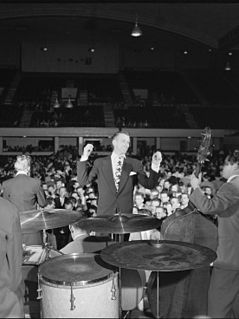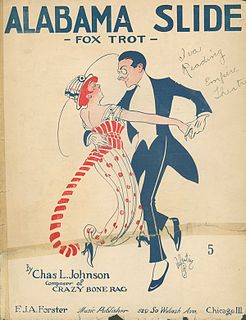Related Research Articles

Dance is a performing art form consisting of sequences of movement, either improvised or purposefully selected. This movement has aesthetic and often symbolic value. Dance can be categorized and described by its choreography, by its repertoire of movements, or by its historical period or place of origin.

Progressive music is music that attempts to expand existing stylistic boundaries associated with specific genres of music. The word comes from the basic concept of "progress", which refers to development and growth by accumulation, and is often deployed in the context of distinct genres, with progressive rock being the most notable example. Music that is deemed "progressive" usually synthesizes influences from various cultural domains, such as European art music, Celtic folk, West Indian, or African. It is rooted in the idea of a cultural alternative and may also be associated with auteur-stars and concept albums, considered traditional structures of the music industry.
Pop is a genre of popular music that originated in its modern form during the mid-1950s in the United States and the United Kingdom. The terms popular music and pop music are often used interchangeably, although the former describes all music that is popular and includes many disparate styles. During the 1950s and 1960s, pop music encompassed rock and roll and the youth-oriented styles it influenced. Rock and pop remained roughly synonymous until the late 1960s, after which pop became associated with music that was more commercial, ephemeral, and accessible.
Rock music is a broad genre of popular music that originated as "rock and roll" in the United States in the late 1940s and early 1950s, developing into a range of different styles in the mid-1960s and later, particularly in the United States and the United Kingdom. It has its roots in 1940s and 1950s rock and roll, a style that drew directly from the blues and rhythm and blues genres of African-American music and from country music. Rock music also drew strongly from a number of other genres such as electric blues and folk, and incorporated influences from jazz, classical, and other musical styles. For instrumentation, rock has centered on the electric guitar, usually as part of a rock group with electric bass, drums, and one or more singers. Usually, rock is song-based music with a 4
4 time signature using a verse–chorus form, but the genre has become extremely diverse. Like pop music, lyrics often stress romantic love but also address a wide variety of other themes that are frequently social or political.
Art rock is a subgenre of rock music that generally reflects a challenging or avant-garde approach to rock, or which makes use of modernist, experimental, or unconventional elements. Art rock aspires to elevate rock from entertainment to an artistic statement, opting for a more experimental and conceptual outlook on music. Influences may be drawn from genres such as experimental rock, avant-garde music, classical music, and jazz.
Progressive rock is a broad genre of rock music that developed in the United Kingdom and United States throughout the mid- to late 1960s. Initially termed "progressive pop", the style was an outgrowth of psychedelic bands who abandoned standard pop traditions in favour of instrumentation and compositional techniques more frequently associated with jazz, folk, or classical music. Additional elements contributed to its "progressive" label: lyrics were more poetic, technology was harnessed for new sounds, music approached the condition of "art", and the studio, rather than the stage, became the focus of musical activity, which often involved creating music for listening rather than dancing.

The Rock and Roll Hall of Fame (RRHOF) is a museum and hall of fame located in downtown Cleveland, Ohio, United States, on the shore of Lake Erie. The museum documents the history of rock music and the artists, producers, engineers, and other notable figures who have influenced its development.

A big band is a type of musical ensemble of jazz music that usually consists of ten or more musicians with four sections: saxophones, trumpets, trombones, and a rhythm section. Big bands originated during the early 1910s and dominated jazz in the early 1940s when swing was most popular. The term "big band" is also used to describe a genre of music, although this was not the only style of music played by big bands.

The foxtrot is a smooth, progressive dance characterized by long, continuous flowing movements across the dance floor. It is danced to big band music. The dance is similar in its look to waltz, although the rhythm is in a 4
4 time signature instead of 3
4. Developed in the 1910s, the foxtrot reached its height of popularity in the 1930s and remains practiced today.
Jazz fusion is a music genre that developed in the late 1960s when musicians combined jazz harmony and improvisation with rock music, funk, and rhythm and blues. Electric guitars, amplifiers, and keyboards that were popular in rock and roll started to be used by jazz musicians, particularly those who had grown up listening to rock and roll.

Art music is music considered to be of high aesthetic value. It typically implies advanced structural and theoretical considerations or a written musical tradition. In this context, the terms "serious" or "cultivated" are frequently used to present a contrast with ordinary, everyday music.
Beat music, British beat, or Merseybeat is a popular music genre, influenced by rock and roll, skiffle, and traditional pop music, that developed in the United Kingdom in the early 1960s.

Acrobatic Rock'n'Roll is a very athletic, competitive form of partner dance that originated from lindy hop. Unlike lindy hop, however, it is a choreographed dance designed for performance. It is danced by both couples and groups, either all-female or four to eight couples together. This is normally a very fast and physically demanding dance.
Post-metal is a style of music that is rooted in heavy metal but explores approaches beyond the genre's conventions. It emerged in the 1990s through the work of bands such as Neurosis and Godflesh who transformed metal texture through experimental composition. Associated with and inspired by post-rock and post-hardcore, the genre employs the darkness and intensity of extreme metal but emphasizes atmosphere, emotion, and even "revelation", drawing on a wide range of sources including ambient, noise, psychedelic, progressive, and classical music to develop an expansive but introspective sound. Post-metal songs are typically long, with loose and layered structures that discard the verse–chorus form in favor of crescendos and repeating themes. The sound centres on guitars and drums; any vocals are usually screamed or growled and resemble an additional instrument.
Art pop is a loosely defined style of pop music influenced by pop art's integration of high and low culture, and which emphasizes the manipulation of signs, style, and gesture over personal expression. Art pop artists may be inspired by postmodern approaches or art theories as well as other forms of art, such as fashion, fine art, cinema, and avant-garde literature. They may deviate from traditional pop audiences and rock music conventions, instead exploring ideas such as pop's status as commercial art, notions of artifice and the self, and questions of historical authenticity.
Radio and Juliet is an hour long ballet setup in 2005 for the Slovenian company Ballet Maribor in Slovenia. It was directed by Romanian dancer and choreographer Edward Clug. The ballet is a rendition of William Shakespeare's Romeo and Juliet set to the music of Radiohead. Since 2005 Radio and Juliet has guested in the Netherlands, Italy, Singapore, Korea, Israel, Canada, United States, Russia, Ukraine, Brazil, Serbia and Croatia. It has also been set on the companies of Bucharest National Theater and Kiev National Opera. On 15 September 2012, the 100th performance was celebrated on the old stage of the Maribor Opera house. The ballet premiered in the United States in 2008 at the Pittsburgh International Festival of Firsts at the Byham Theater.
Progressive pop is pop music that attempts to break with the genre's standard formula, or an offshoot of the progressive rock genre that was commonly heard on AM radio in the 1970s and 1980s. It was originally termed for the early progressive rock of the 1960s. Some stylistic features of progressive pop include hooks and earworms, unorthodox or colorful instrumentation, changes in key and rhythm, experiments with larger forms, and unexpected, disruptive, or ironic treatments of past conventions.
Electronic rock is a music genre that involves a combination of rock music and electronic music, featuring instruments typically found within both genres. It originates from the late 1960s, when rock bands began incorporating electronic instrumentation into their music. Electronic rock acts usually fuse elements from other music styles, including punk rock, industrial rock, hip hop, techno, and synth-pop, which has helped spur subgenres such as indietronica, dance-punk, and electroclash.
Avant-funk is a music style in which artists combine funk rhythms with an avant-garde or art rock mentality. Its most prominent era occurred in the late 1970s among post-punk acts who embraced black dance styles.
References
- ↑ Stephen Downes Aesthetics of Music: Musicological Perspectives 2014 1136486917 p33 "Rock and roll has to be body music, before it can be head music, or it will wind up being neither' (Landau 1972, 134)."
- ↑ Christopher Partridge, Marcus Moberg The Bloomsbury Handbook of Religion and Popular Music 2017 1474237355- Page 61 "With progressive rock, the programme was to innovate, to experimentformally, and to offer 'head music' for thinking rather than body music for dancing."